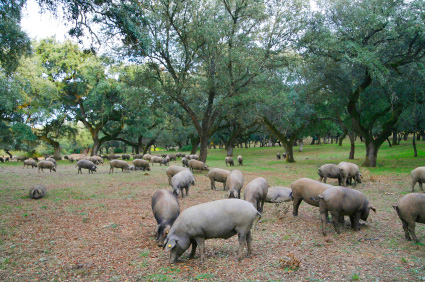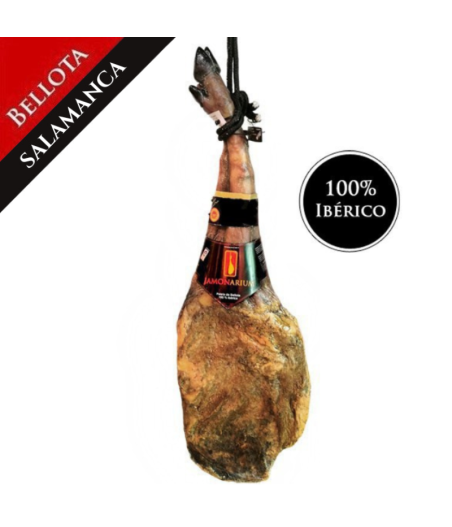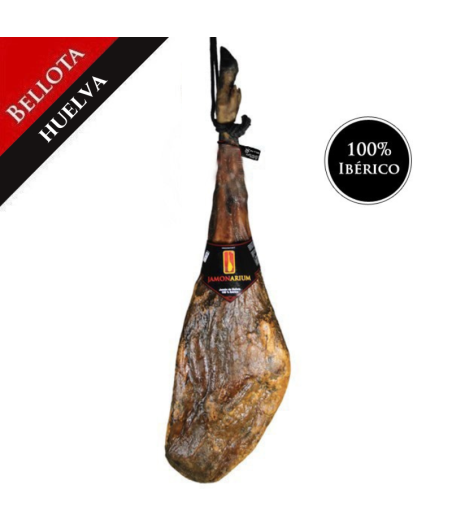Pata Negra Ham: curiosities and myths
- What is a Pata Negra ham?
- Characteristics of 100% pure Pata Negra and other Iberian Bellota
- What is the shape of Pata Negra hams?
- Is there any relationship between the Iberian Hams and Pata Negra Hams? Production areas
- How long does the curing process of Pata Negra hams?
- Is there a minimum weight to identify Pata Negra Hams?
- What do they look like the 100% Iberian Pata Negra hams?
- Do all Pata Negra hams have black hoofs?
- What brands of Pata Negra 100% Iberico Bellota hams and shoulders exist?
1. What is a Pata Negra ham?
Traditionally it is said Pata Negra ham to the Iberian hams for its black hoof.
Over the time it has been a term that assign quality for many products, say that a product is Pata negra is to say that is highest quality.
There are many people, especially outside Spain referred to Pata negra as the Bellota Iberian ham, for being the highest quality.
After the entry of the labeling rules for hams in 2014, the term Pata negra is only officially applicable to the Iberian Bellota hams 100% pure.
2. Characteristics of 100% pure Pata Negra and other Iberian Bellota
Pure Pata Negra ham comes from pigs raised in freedom in the pastures Iberian 100% and fed with natural grass and acorns.
The result is more fat around hams and less fat infiltrated, a darker color and higher price because their production is lower.
Iberian crossed breed could also be of the highest quality, they have simply been crossed in a grade between 50% and 99% with another similar race.
The result is Bellota hams or cebo with more fat infiltration in the meat, it makes them very mellow and perhaps less strong flavor. The appearance of the meat has a fine marbling of fat, which makes it so juicy.
Still, the Iberians hams quality, pure or not, depends on:
The first is how the pigs have been raised and the second the curing process of the ham. This last stage can make the 50% Iberian bellota ham tastier than the 100% Iberian bellota ham.

3. What is the shape of Pata Negra hams?
The outer shape of pata negra hams quality is stylized, thin and elongated. The color range goes from pink to purple red. Its aromas are intense, pleasant and full of nuances, and its very delicate flavor and slightly salty.
The meat is less fibrous and fat has a shiny appearance.
It is important the texture of the fat. To the touch, the 100% Iberian bellota quality is so subtle that it is easy to merge smoothly with the palm of the hand.
Also at time to cut it, something that only experts cutters can recognize, the finest ones always are easier to cut.

4. Is there any relationship between the Iberian Hams and Pata Negra Hams? Production areas
In Spain it is very common name the pata negra ham as Jabugo ham, but this rating is only valid for certain hams from Jabugo.
That is, not because the ham comes from Jabugo is 100% or pure Iberian pata negra, as Jabugo is one of 31 municipalities that are part of the D.O. Jabugo hams and produce different qualities and types.
The pata negra hams are produced in four areas of Spain, such as Extremadura (D.O. Dehesa de Extremadura), Salamanca (D.O. Guijuelo), Huelva (D.O. Jabugo) and Pedroches (D.O. Los Pedroches), with pigs raised on the peninsula and the indicated race.

Our Pata Negra 100% Iberian hams and shoulders
5. How long does the curing process of Pata Negra hams?
Every ham has his time depending on the quality and weight. The more bigger they are, the more curing process and time they need. Usually, this period ranges about 36 months. Concerning the shoulder hams, the minimum time to consider the ham as good quality, is about 24 months. Obviously, if the weight is greater, so curing process must be. A 8Kg ham entails a longer curing process than one with 6kg.
6. Is there a minimum weight to identify Pata Negra Hams?
The Iberian ham pata negra reaches its peak immediately after the montanera period (the period where the pig goes through the mountain to feed on acorns), and reach a minimum age of entry in montanera of 10 months. Their average weight to enter in montanera between 80.5 and 115 kilos and during this period earn at least 46 kilos.
7. What do they look like the 100% Iberian Pata Negra hams?
100% Iberian pigs are a breed of animal with Mediterranean origin. Pigs are blacks, with almost hairless: “lampiños”. Usually thinner than other similar races, in part because they move more, they walk around 14 km per day in search of acorns. They have long straight nose and a thin skeleton.

8. Do all Pata Negra hams have black hoofs?
Most of the 100% Iberian Bellota Pata negra hams have black hoof. However, there are fews with the clear hoof, without meaning low or less quality.
There are also other races like Duroc hams with black-hoofed but are neither Pata Negra nor Iberian.

9. What brands of Pata Negra 100% Iberico Bellota hams and shoulders exist?
Pata Negra 100% Iberian Bellota hams and shoulders are among the best valued on the market. Some of the best known brands of Pata Negra 100% Iberico Bellota hams are Jamonarium and Cinco Jotas. Joselito hams are excluded from the Iberian Standard, but they have a very high quality.
 4,9 / 5
4,9 / 5 

































